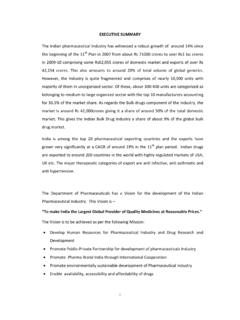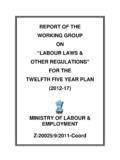Transcription of Structuring PPPs in Aviation Sector: Case of Delhi …
1 Structuring ppps in Aviation sector : Case of Delhi and mumbai airport privatization The concession agreement for the modernization and operation of Indira Gandhi International airport in Delhi and Chhatrapati Shivajirespectively is referred to as The OMDA was a part of a set of transaction documents along with the request for proposal provided to potential bidders. The OMDA laid out the contractual terms for Structuring the PPP. This paper discusses the evolution of the draft OMDA from when it was April 2005 to the bidders till it wasextended bidding date. During this period, some of the critical issues addressed were: limits to commercial development of airport land, nature of tarliabilities including performance bonds and termination payments, and potential contractual and strategic conflicts.
2 It brings out the intrasignificant learning that formed part largest in the world. The Inter Ministerial Group (IMG), constituted by Ministry of Civil Aviation (MoCA) to assist the Empowered Group of Ministers (EGoM), had been seized of various issues in the course of awarding long term concessions for theefforts to attract private participation National Democratic Alliance government in September 2003 to restructure Delhi anMumbai airports. The idea was to bring in the private sector through a long term concession by setting up a Joint Venture (JV) of a private player (or a consortium) with the Airports Authority of India (AAI). The AAI was a public sector entity owninmanaging Delhi , mumbai and all other commercial airports in India, excluding Cochin. 1 Prepared by Profs.
3 Ajay Pandey, Sebastian Morris and G. Raghuram of the Indian Institute of Management Ahmedabad. Authors can be contacted at respectively. This case is based mainly on secondPrivatization: Bidding Process for Delhi and mumbai (A), (B), (C), (D) and (E) written by Prof Rekha Jain, Prof G Raghuram and Rachna Gangwar of Indian Institute of Management Ahmedabad. In also makes use of information obtained from public authorities involved in the process of privatization of these airports. The OMDA is available on the website of Airports Authority of India (writers are grateful for the comments provided by Planning Commission, Ms Namita Mehrotra, Director Planning Commission and Ms Anna Roy, Director, Ministry of Finance. The writers are Teaching material of the Indian Institute of Management, Ahmedabad is prepared as a basis for class discussion.)
4 Cases are not designed to present illustrations of either correct or incorrect handladministrative problems. Copyright 2010by the Indian Institute of Management, Ahmedabad and the Planning Commission, Government of India Structuring ppps in Aviation sector : Case of Delhi and mumbai airport Privatization1 he concession agreement for the modernization and operation of Indira Gandhi International airport in Delhi and Chhatrapati Shivaji International airport at Mumbairespectively is referred to as Operation Management and Development Agreement (OMDA). The OMDA was a part of a set of transaction documents along with the request for proposal provided to potential bidders. The OMDA laid out the contractual terms for Structuring the the evolution of the draft OMDA from when it was April 2005 to the bidders till it was released as a final OMDA in August 2005 During this period, some of the critical issues addressed were: limits to commercial development of airport land, nature of tariff regulatory regime, contingent liabilities including performance bonds and termination payments, and potential contractual and strategic conflicts.
5 It brings out the intra-governmental issues and processes, and the significant learning that formed part of these PPP concessions, which could well be among the The Inter Ministerial Group (IMG), constituted by Ministry of Civil Aviation (MoCA) to assist the Empowered Group of Ministers (EGoM), had been seized of various issues in awarding long term concessions for the Delhi and mumbai Airports. These to attract private participation were initiated following the Cabinet decision of the National Democratic Alliance government in September 2003 to restructure Delhi anMumbai airports. The idea was to bring in the private sector through a long term by setting up a Joint Venture (JV) of a private player (or a consortium) with the Airports Authority of India (AAI). The AAI was a public sector entity owninmanaging Delhi , mumbai and all other commercial airports in India, excluding Cochin.
6 Prepared by Profs. Ajay Pandey, Sebastian Morris and G. Raghuram of the Indian Institute of Management Ahmedabad. Authors can be contacted at This case is based mainly on secondary information. It borrows facts from the cases titled airport privatization : Bidding Process for Delhi and mumbai (A), (B), (C), (D) and (E) written by Prof Rekha Jain, Prof G Raghuram and Rachna Gangwar of Indian Institute of Management Ahmedabad. In also makes use of information obtained from public authorities involved in the process of privatization of The OMDA is available on the website of Airports Authority of India ( are grateful for the comments provided by Shri Gajendra Haldea, Adviser to Deputy Chairman,Planning Commission, Ms Namita Mehrotra, Director Planning Commission and Ms Anna Roy, Director, Ministry of Finance.)
7 The writers are, however, solely responsible for any errors of fact or material of the Indian Institute of Management, Ahmedabad is prepared as a basis for class discussion. Cases are not designed to present illustrations of either correct or incorrect handlby the Indian Institute of Management, Ahmedabad and the Planning Commission, 1 Case Study he concession agreement for the modernization and operation of Indira Gandhi International airport at mumbai Operation Management and Development Agreement (OMDA). The OMDA was a part of a set of transaction documents along with the request for proposal provided to potential bidders. The OMDA laid out the contractual terms for Structuring the the evolution of the draft OMDA from when it was first released in in August 2005 before an During this period, some of the critical issues addressed were: limits to iff regulatory regime, contingent liabilities including performance bonds and termination payments, and potential contractual governmental issues and processes, and the of these PPP concessions, which could well be among the The Inter Ministerial Group (IMG), constituted by Ministry of Civil Aviation (MoCA) to assist the Empowered Group of Ministers (EGoM), had been seized of various issues in Delhi and mumbai Airports.
8 These were initiated following the Cabinet decision of the National Democratic Alliance government in September 2003 to restructure Delhi and mumbai airports. The idea was to bring in the private sector through a long term PPP by setting up a Joint Venture (JV) of a private player (or a consortium) with the Airports Authority of India (AAI). The AAI was a public sector entity owning and managing Delhi , mumbai and all other commercial airports in India, excluding Cochin. Prepared by Profs. Ajay Pandey, Sebastian Morris and G. Raghuram of the Indian Institute of Management and ary information. It borrows facts from the cases titled airport privatization : Bidding Process for Delhi and mumbai (A), (B), (C), (D) and (E) written by Prof Rekha Jain, Prof G Raghuram and Rachna Gangwar of Indian Institute of Management Ahmedabad.
9 In addition, this case also makes use of information obtained from public authorities involved in the process of privatization of ). The to Deputy Chairman, Planning Commission, Ms Namita Mehrotra, Director Planning Commission and Ms Anna Roy, Director, lely responsible for any errors of fact or interpretation. Teaching material of the Indian Institute of Management, Ahmedabad is prepared as a basis for class discussion. Cases are not designed to present illustrations of either correct or incorrect handling of by the Indian Institute of Management, Ahmedabad and the Planning Commission, 2 Bangalore and Hyderabad airports had also been awarded to private entities on Public Private Partnership (PPP) basis in 2004. The motivation for this move was to develop the airports of India s two most important cities as world class airports.
10 There was much that was lacking in the operations at these airports. Demand had grown very rapidly, especially since the reform of the Indian economy in the early nineties (Exhibit 1). The entry of private players in the domestic airline industry had led to a steady growth in traffic and improvement in the quality of flight services. Ground level services, however, had not improved, leading to growing congestion and difficulty imposed on passengers at airports. Facilities were poor, even in areas that could be considered as basic toilets and restaurants at airports, lounge facilities, connectivity from one terminal to another, and clearance of baggage. Major airports also had passenger related commercial activities like shopping areas, travel related services, cargo and warehousing facilities etc. In comparison to similar sized airports, internationally and more particularly of neighboring South East Asian countries, this potential had not been fully exploited in mumbai or Delhi airports.









